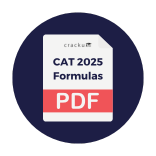TS Police SI Mains 2018 Arithmetic and Reasoning
To answer the following questions consider the following information.
Given that
U = {1, 2, 3, ......., 500}
A = the set of all multiples of 6 in U,
B = the set of all multiples of 15 in U and
C = the set of all multiples of 10 in U.
Let $$\mid S \mid$$, denotes the number of elements in a set S. Then
TS Police SI Mains 2018 Arithmetic and Reasoning - Question 141
$$\mid (A \cup B \cup C) \mid = $$
TS Police SI Mains 2018 Arithmetic and Reasoning - Question 142
The number of integers in U that are divisible by exactly any two of 2, 3, 5 is
Consider the following information.
In a hostel there are 220 students. Out of them 105 read newspaper A, 90 read newspaper B, 75 read newspaper C. 35 read both A and B. 20 read both A and C, 23 read bath B and C and 9 read all three newspapers. Then
TS Police SI Mains 2018 Arithmetic and Reasoning - Question 143
Number of students who do not read any newspaper is
TS Police SI Mains 2018 Arithmetic and Reasoning - Question 144
Number of students who read only one newspaper Is
TS Police SI Mains 2018 Arithmetic and Reasoning - Question 145
Number of students who read exactly two newspapers Is
TS Police SI Mains 2018 Arithmetic and Reasoning - Question 146
Number of students who read newspapers B and C but not A is
TS Police SI Mains 2018 Arithmetic and Reasoning - Question 147
Number of students who read two or less number of newspapers is
For the following questions answer them individually
TS Police SI Mains 2018 Arithmetic and Reasoning - Question 148
In a college having 600 science students, 450) students are doing Physics, 300 students are doing Mathematics and 400 students are doing Chemistory On These students 180 students are doing both Physics and Mathematics and 350 students are doing Physics and Chemistry 200 students are studying all three subjects. Then the number of students doing both Mathematics and Chenustry is
TS Police SI Mains 2018 Arithmetic and Reasoning - Question 149
A misfit in the following sequence
1682, 1683, 1684, 1685, 1686, 1687, 1688, 1689, ...
TS Police SI Mains 2018 Arithmetic and Reasoning - Question 150
In the following figure, the regions 1, 2, 3, 4, 5, 6, 7, 8 are shaded with the colours Voilet (V), Purple (P), Blue (B), Yellow (Y), Orange (O), Red (R), Green (G) and Maroon (M) respectively. If the figure is reflected with respect to $$l_1$$ and then reflected with respect to $$l_2$$ then the new order of the colours in the clockwise direction



